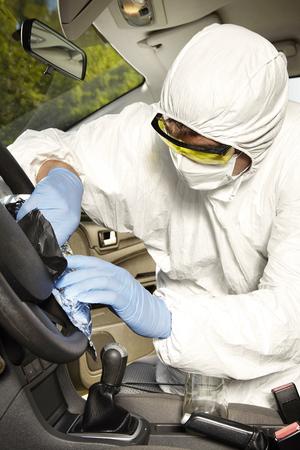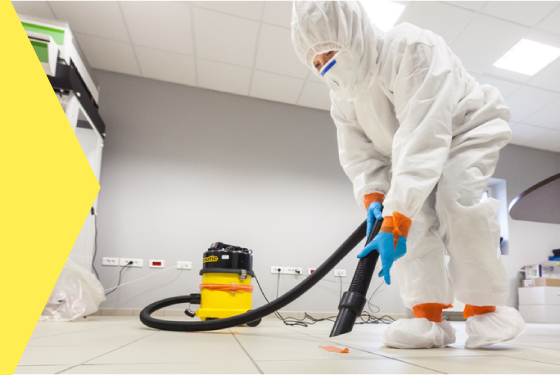Biohazard Removal: Safe Handling and Disposal of Hazardous Products
Biohazard Removal: Safe Handling and Disposal of Hazardous Products
Blog Article
Professional Biohazard Cleansing and Purification for Blood, Bodily Fluids, and Hazardous Products
The potential health threats linked with exposure to biohazards emphasize the vital demand for meticulous handling and thorough cleaning. As we browse the detailed landscape of biohazard cleanup, understanding the nuances of guidelines, conformity, and the specialized equipment at play becomes critical in making certain a secure and detailed decontamination process.
Wellness Dangers of Biohazard Direct Exposure
Direct exposure to biohazards presents substantial health and wellness dangers that can result in serious repercussions for individuals and areas alike. Biohazards include a variety of biological compounds, including blood, physical fluids, mold and mildew, germs, viruses, and other possibly infectious materials. When people enter call with these biohazards, whether with mishaps, improper handling, or ecological exposure, they encounter the danger of having major ailments or diseases.
Among the key wellness dangers connected with biohazard exposure is the transmission of transmittable diseases. Bloodborne virus such as HIV, hepatitis B and C, and different bacteria can be existing in biohazardous materials, posing a direct threat to human health. Breathing in airborne biohazards like mold and mildew spores or coming into contact with polluted surfaces can additionally bring about breathing issues, allergies, and various other damaging health results.
Additionally, biohazard direct exposure can have long-term health implications, with some diseases materializing years after the preliminary call (Blood Cleanup). For that reason, it is important to prioritize correct biohazard cleansing and purification to mitigate these health and wellness risks and ensure the security of neighborhoods and individuals

Specialized Training for Biohazard Cleanup
When it concerns taking care of biohazard cleanup effectively and safely, specialized training plays a basic duty in making sure appropriate decontamination procedures are complied with. Biohazard cleanup calls for specific expertise and skills to efficiently mitigate threats related to bloodborne microorganisms, bodily fluids, and dangerous materials. Experts educated in biohazard cleaning go through rigorous instruction on how to securely deal with, remove, and get rid of biohazardous products to stop contamination and exposure.
Specialized training for biohazard cleaning covers a series of important subjects, consisting of proper individual safety equipment (PPE) usage, bloodborne virus awareness, purification strategies, and contaminated materials disposal procedures. People learnt biohazard clean-up are geared up with the needed competence to assess contamination degrees, recognize potential threats, and execute proper clean-up procedures in conformity with regulative requirements.
Constant training and education and learning are extremely important in the area of biohazard clean-up to remain upgraded on the latest decontamination innovations, safety and security procedures, and guidelines. By purchasing specialized training, biohazard cleanup professionals can efficiently react to emergency cleanup situations and protect both public health and the environment.
Importance of Correct Purification Strategies
Using appropriate decontamination strategies is important in biohazard cleaning to efficiently get rid of dangerous materials and lessen wellness threats. Reliable decontamination not just guarantees the removal of noticeable traces of blood, physical fluids, and other biohazards however additionally targets invisible virus that may present significant wellness threats if not correctly gotten rid of. By following stringent purification procedures, educated professionals can dramatically reduce the danger of exposure to harmful microorganisms, infections, and bacteria that might bring about illness or infections.
Appropriate purification methods include using customized devices and anti-bacterials that are especially developed to reduce the effects of biohazards effectively. Complete cleaning and sanitation of infected locations are necessary to protect against the spread of pathogens and ensure a safe environment for occupants. Additionally, the right disposal of biohazardous waste following decontamination treatments is important in stopping contamination of other surface areas or people.

Equipment and Devices for Safe Cleanup
When dealing with blood, physical liquids, or hazardous products, biohazard cleansing experts rely on specialized gear to minimize direct exposure dangers and thoroughly decontaminate the afflicted area. In addition, biohazard cleansing kits containing anti-bacterials, absorptive materials, and biohazard bags are utilized to safely include discover this info here and get rid of of contaminated products.
Advanced cleaning tools like hospital-grade anti-bacterials, HEPA-filtered vacuum cleaners, and misting machines are used to sterilize surface areas and get rid of biohazards properly. Specialized equipment such as sharps containers and biohazard waste disposal containers are made use of to securely manage sharp objects and biohazardous waste materials. By making use of the best equipment and tools, biohazard cleansing experts can make sure a thorough clean-up process that prioritizes security and minimizes health threats for both employees and occupants of the damaged room.
Regulations and Compliance in Biohazard Cleaning
Proper adherence to guidelines and conformity standards is vital in biohazard cleaning to make sure the safety of both employees and the environment. Federal government biohazard cleanup equipment agencies such as OSHA (Occupational Safety And Security and Wellness Administration) and the EPA (Environmental Defense Agency) have actually developed particular standards for biohazard cleanup procedures to lessen health dangers and ecological contamination. These policies cover a series of aspects consisting of the handling, transportation, and disposal of biohazardous materials, as well as the needed training and safety devices required for workers involved in the cleanup procedure.
Biohazard cleansing companies must stay updated with these laws to guarantee that their operations satisfy the needed safety and security criteria. Failure to follow these regulations can result in extreme effects, including penalties, lawful activity, and threatening the health and wellness of people and the setting. By complying with strict guidelines and compliance actions, biohazard cleansing companies can properly alleviate threats and ensure a risk-free and detailed cleaning procedure for all events involved.
Final Thought
In final thought, biohazard cleaning and purification require customized training, correct methods, and adherence to laws. Direct exposure to blood, physical fluids, and dangerous materials presents significant health dangers, making it crucial to utilize the best devices and tools for safe cleaning. By following strict methods and standards, specialists can successfully reduce the risks linked with biohazard exposure and guarantee the security of both themselves and others.
As we browse the complex landscape of biohazard cleanup, understanding the nuances of policies, compliance, and the customized devices at play ends up being necessary in making sure a safe and thorough purification procedure. (Blood Cleanup)
When it directory comes to dealing with biohazard clean-up successfully and safely, specialized training plays a basic duty in making certain proper purification procedures are followed.Making use of proper decontamination strategies is crucial in biohazard cleanup to successfully eliminate hazardous materials and lessen health risks. Furthermore, biohazard cleansing packages including anti-bacterials, absorptive materials, and biohazard bags are made use of to safely include and dispose of polluted things.
Federal government agencies such as OSHA (Occupational Safety And Security and Health And Wellness Management) and the EPA (Environmental Defense Company) have established details guidelines for biohazard clean-up procedures to decrease health dangers and environmental contamination.
Report this page